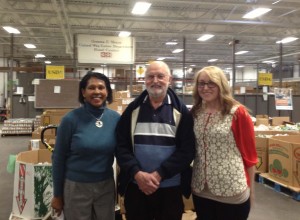Food insecurity a complicated problem in Conn.
Posted: April 10, 2013 Filed under: General, Health, Income, Nutrition Leave a comment »
Katherine Sebastian-Dring who work at the Gemma E. Moran United Way Labor/Food Center stands on the left, next to Bob Davoy who runs a food pantry in downtown New London. Mary Gates (right) is an Americorp VISTA for the New London Food Policy Council.
Recently a national anti-hunger advocacy group ranked Connecticut as the 6th best state for access to affordable and nutritious food—what’s also called community food security. But a study released Wednesday by UConn’s Zwick Center for Food and Resource Policy shows that things are pretty tough in some areas.
You can hear Will Stone’s report on food insecurity here:
ws_foodsecurity_130409
1 in 6 children in New London County is food insecure. That means they and their families don’t have reliable access to affordable food for a number of reasons—transportation, education, geography and income, all play a role.
It’s not all about economic disparity for this issue. The per capita income in the city of New London is $21,000, while neighboring Stonington is almost twice that. But the report shows Stonington still has a higher than average risk of food insecurity.
“Every town in the county has an at-risk population,” says Mary Gates, who’s been conducting focus groups on food insecurity for the New London Food Policy Council. “I want to make sure that people don’t look at Stonington or Mystic and say there can’t be hungry people there.”

Recent Comments